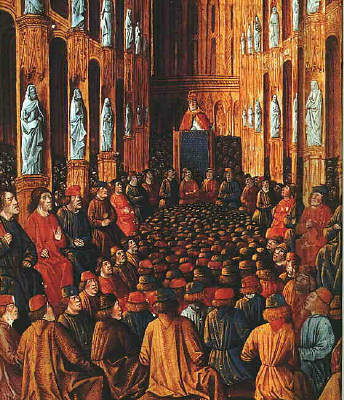 The Story Thus Far: The Christian “Reconquista” movement against the Moorish occupation of the Iberian Peninsula and “Mad” Caliph al-Hakim bin-Amr Allah’s 1009 destruction of the Church of the Holy Sepulchre in Islam-controlled Jerusalem finally directed the attention of mostly Christian Western Europe to the now-mostly Muslim Middle East
The Story Thus Far: The Christian “Reconquista” movement against the Moorish occupation of the Iberian Peninsula and “Mad” Caliph al-Hakim bin-Amr Allah’s 1009 destruction of the Church of the Holy Sepulchre in Islam-controlled Jerusalem finally directed the attention of mostly Christian Western Europe to the now-mostly Muslim Middle East
The still-more-or-less-united Orthodox Church didn’t act immediately against the “infidel,” since it still had to convert and/or deal with non-Christians and “wrong” Christians, often violently. In Toulouse in 1022, it executed members of an originally Eastern European sect that had first appeared in the Limousinprovince of France between 1012 and 1020, a sect later popular enough to lead the 1028 Synod of Charroux (Vienne) to condemn it as heretical. They appear to have referred to themselves as the “pure ones” in Greek, a term later translated to “Cathars.”
However, a huge crisis was brewing between Rome, still capital (although basically in name only) of the mostly-defunct Western Roman Empire, and Constantinople, the capital of the surviving Eastern Roman Empire. I liken it to a marriage in which disagreements that had been boiling beneath the surface finally burst into the open. The irreconcilable doctrinal differences cited on both sides included the Filioque Controversy, East vs. West jurisdictional disputes, and dissent over liturgical practices like unleavened bread (originally a Jewish custom) at theEucharist.
As in an estranged marriage, the final blow-out fight began in 1053, when the Normans took and held Pope Leo IX prisoner in Benevento; under his influence, they started incorporating Latin/Western practices like the unleavened bread mentioned above. In retaliation, Patriarch Cerularius of Constantinople ordered the Latin churches in his city to follow Eastern/Byzantine practices; when they refused, he closed them down and issued a scathing letter to all Western bishops decrying these practices as “Judaistic” (too Jewish-y, basically).
The Western Archbishop Humbert of Mourmoutiers of Silva Candida carried the letter to Leo IX, who immediately ordered a reply responding to each charge and confirming Roman papal supremacy. He sent it with Humbert and two other papal legates to Constantinople in April 1054, where unhappy with their reception by Patriarch Cerularius, all three stormed out. Noting with rising anger that the legates had unsealed, tampered with, and replaced the pope’s letter with an earlier, less polite Greek draft for everyone to read, he let them cool their heels in the Byzantine capital, barely acknowledging their presence.
Even though Leo died on April 19 and with him the legates’ papal authority, on July 16 they laid abull of excommunication against the patriarch on the altar of the Hagia Sophia at high Mass and split for Rome two days later, leaving behind a city near chaos. Popular support heavily favored Cerularius, and so the bull was burnt and the three legates anathematized. Two separate Christian churches remained standing when the smoke from the Big Break-Up (theGreat or East-West Schism to historians) finally cleared: the Roman Catholic and Eastern Orthodox.
I can only imagine what a blow this must have been to those church leaders who had a vision of a world united under a single Christian banner (Eastern or Roman, take your pick). I wonder if the trauma of this religious divorce is what exacerbated the already-existent intolerance toward dissenting views within Christendom, because the Catholic Church in particular focused even more strongly on suppressing heresy. And there were those Muslims occupying its Holy Land to focus its frustration on as well…
The 1056 Synod of Toulouse further condemned the Cathar doctrine, and preachers flocked to the region to denounce it. In 1057, Norman Christian Robert Guiscard conquered and held traditionally Byzantine Calabria against the Sicilian Muslims. Roman Catholic Pope Alexander II took the time in 1063 to openly and officially bless the Iberian Christians in their “Reconquista.” And at 1071’s Battle of Manzikert the Byzantines lost most of Asia Minor to the Muslim Seljuqs.
This loss to Christendom in general may have prompted Byzantine Emperor Michael VII Ducas/Parapinakes to ask Pope Gregory VII for help against the Muslims in 1074. However, the Investiture Controversy intervened in 1075 to command Greg’s attention, and Europe found itself preoccupied with the issue of whether only the pope had the authority to appoint church officials, a right that secular leaders had been claiming for centuries past. This controversy lasted for several decades and eventually led to 50 years’ worth of civil war in Germany.
Islam once again commanded Europe’s attention in 1085, when the Christian kingdom of Leon in Spain seized the city of Toledo from the Moors, and ten years later in 1095, when Byzantine Emperor Alexius I Comnenus requested Pope Urban II’s aid in fighting the Muslims. The time had finally come for action against the unbelievers; at the Council of Clermont, before an assembly of clergy and secular leaders, Urban II called all Christians to a “holy war” vs. Islam:
Let those who have been accustomed unjustly to wage private warfare against the faithful now go against the infidels and end with victory this war which should have been begun long ago. Let those who for a long time, have been robbers, now become knights. Let those who have been fighting against their brothers and relatives now fight in a proper way against the barbarians. Let those who have been serving as mercenaries for small pay now obtain the eternal reward. Let those who have been wearing themselves out in both body and soul now work for a double honor.
He concluded his call to action with the battle cry: “Deus vult (God wills it)!”
And the First Crusade was on.
No comments:
Post a Comment